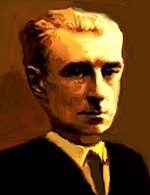|
Xtend
 Listen
Listen
 Period
Period
 Country
Country
 Notes
Notes
 Quotation
Quotation
 Projects
Projects
 Dictionary
Dictionary
 Finders
Finders
|

Born: 7 March 1875, Ciboure,
France
Died: 28 December 1937, Paris, France
Ravel, Maurice
When he was 14, Ravel was accepted
to the Conservatoire of Paris ,
where he was later taught composition by Fauré ,
where he was later taught composition by Fauré .
He began writing piano .
He began writing piano works, and soon enough gained a reputation
as a successful innovator, a rebel against
musical conventions. He became famous as an
excellent orchestrator
works, and soon enough gained a reputation
as a successful innovator, a rebel against
musical conventions. He became famous as an
excellent orchestrator ,
and his orchestration of Mussorgski's ,
and his orchestration of Mussorgski's "Pictures at an Exhibition"
"Pictures at an Exhibition" made this piece very popular in symphonic concert halls. His piano work
"The Night's Gaspar"
made this piece very popular in symphonic concert halls. His piano work
"The Night's Gaspar" ("Gaspard
de la nuit"), written under Liszt's
("Gaspard
de la nuit"), written under Liszt's musical inspiration, and the ballet
musical inspiration, and the ballet music "Daphnis
and Chloe" ("Daphnis
et Chloé"), he wrote in response to a commission
from the Russian impressario Dyagilev
and was based on an ancient Greek
myth, were a great success in Paris
and recognized as masterpieces.
music "Daphnis
and Chloe" ("Daphnis
et Chloé"), he wrote in response to a commission
from the Russian impressario Dyagilev
and was based on an ancient Greek
myth, were a great success in Paris
and recognized as masterpieces.
After World War I, in which he served
as an ambulance driver, he believed France's golden age should be restored, and wrote the "Pavane
to a Deceased Princess"
golden age should be restored, and wrote the "Pavane
to a Deceased Princess"  ("Pavane pour une infante défunte"),
and "The tomb of
Couperin" ("Le
tombeau de Couperin"), two works that revive Baroque
("Pavane pour une infante défunte"),
and "The tomb of
Couperin" ("Le
tombeau de Couperin"), two works that revive Baroque dance forms. Ravel also wrote the Concerto
for the Left Hand, for the pianist Paul
Wittgenstein who lost his right arm in the
war, and wanted to continue playing in concert halls.
dance forms. Ravel also wrote the Concerto
for the Left Hand, for the pianist Paul
Wittgenstein who lost his right arm in the
war, and wanted to continue playing in concert halls.
Ravel's deteriorating health did
not prevent him from traveling around the world and gain a great deal of
appreciation, and in 1928, came his famous,
scandalous Ballet work: "Bolero"  ("Boléro").
In this piece, described by Ravel himself as "crescendo
("Boléro").
In this piece, described by Ravel himself as "crescendo for orchestra", the theme is repeated over and over, as more instruments
keep joining, and volume increases until the shivering final chord. This
fascinating piece is viewed as one of the most interesting works of the
20th century
for orchestra", the theme is repeated over and over, as more instruments
keep joining, and volume increases until the shivering final chord. This
fascinating piece is viewed as one of the most interesting works of the
20th century . .


Ravel on the WWW
 Sites
Sites
|
 Audio
Audio
|
 Video
Video
|
 Images
Images
|
 MIDI
MIDI
|
|
Description
He played

He Was

He Lived in the
 Romantic
Impressionism
Romantic
Impressionism
In
 France
France
|